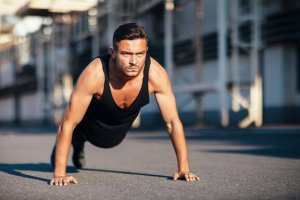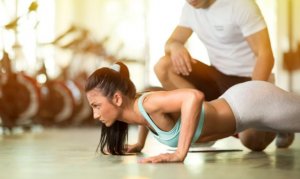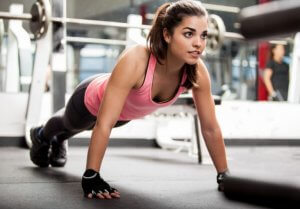Push-ups to Work your Triceps and Main Chest Muscles

Push-ups are one of the most popular and used exercises by people who want to strengthen and increase the muscle mass in their pecs and triceps. However, these exercises involve many other muscle groups; some of them are obvious, and others are more unexpected.
Push-ups are, without a doubt, a very effective way to strengthen your upper body. There are many versions of this classic exercise, and they vary depending on the area that you want to target the most.
Just as with many other exercises, it’s important to get the right technique when performing push-ups to avoid possible injuries. Next up, we’ll take a look at some of the elements involved. Learn more about push-ups, their technique and the muscles involved in the movement.
What are push-ups?
A push-up refers to the movement through which we lift our body from the ground. To do push-ups you don’t require any equipment, just your body.
The goal is to lift your body, meaning all your weight, using the strength of your arms. To do this, you must extend your elbows and flex your shoulders.
To explain it in a simple way, the exercise consists of lying face down with your chest and abdomen against the floor, your arms bent and the palms of your hands touching the floor next to your chest. You must then lift your body up until your arms are completely stretched out, and going back down to touch the floor with your body in a controlled movement.

Push-ups are useful to increase the strength of your upper body, mainly your chest and arms. Both men and women can perform this exercise to strengthen these muscle groups.
A good technique
In order for push-ups to be completely effective, and most of all to prevent back injuries, it’s important to have a good technique before doing them. First, you must get into a plank position; your body should be in a straight line, with the palms of your hands and the tips of your feet as the only points of support. You should keep your stomach tight to protect your spine.
Your arms should be a bit more separated than shoulder-width and your feet should remain hip-width apart. Both sets of extremities must be completely stretched out.
From that position, which you must do perfectly right, you can begin to do push-ups. Flex your elbows until your chest touches the ground.
Next, return to the starting position, with your arms extended. This is the hardest part of the exercise because when you lift your body weight, it will totally lean on the muscles of your arms.

Main muscles involved in push-ups
Push-ups are a very complete movement, which involves every muscle in the upper part of your body. The main affected muscle is the pectoral muscle, as it receives a great stimulus during this movement; undoubtedly, this is the muscle that you strengthen the most.
Other muscles that work intensely during a push-up are the triceps and deltoid muscles, in the shoulder area. However, there are also other muscles that make great efforts to stabilize the rest of your body during the exercise.
When you do push-ups, you work the muscles in the central area of your body, also known as the core. This area has a stabilizing function to maintain the posture of your body during the exercise.
Working many muscles
Push-ups work all your abs silently. The rectus abdominis muscle, external and internal obliques and the transverse abdominal muscle. The latter helps the spine to stay in a stable and neutral position during the movement.

The gluteus maximus is in charge of keeping your hips up and preventing them from tilting forward. It also works on maintaining the posture of the erector spinae muscle, which is the muscle that’s next to your spine.
However, it’s important that the strength for lifting your body weight comes mainly from the pectoral muscles, arms, and shoulders. The result is similar to CrossFit techniques.
The rest of your muscle groups are the companions that guarantee good posture and work for them, but with another intensity level. If, for example, the strength comes from your back muscles, you can suffer severe injuries.
Push-ups are one of the most popular and used exercises by people who want to strengthen and increase the muscle mass in their pecs and triceps. However, these exercises involve many other muscle groups; some of them are obvious, and others are more unexpected.
Push-ups are, without a doubt, a very effective way to strengthen your upper body. There are many versions of this classic exercise, and they vary depending on the area that you want to target the most.
Just as with many other exercises, it’s important to get the right technique when performing push-ups to avoid possible injuries. Next up, we’ll take a look at some of the elements involved. Learn more about push-ups, their technique and the muscles involved in the movement.
What are push-ups?
A push-up refers to the movement through which we lift our body from the ground. To do push-ups you don’t require any equipment, just your body.
The goal is to lift your body, meaning all your weight, using the strength of your arms. To do this, you must extend your elbows and flex your shoulders.
To explain it in a simple way, the exercise consists of lying face down with your chest and abdomen against the floor, your arms bent and the palms of your hands touching the floor next to your chest. You must then lift your body up until your arms are completely stretched out, and going back down to touch the floor with your body in a controlled movement.

Push-ups are useful to increase the strength of your upper body, mainly your chest and arms. Both men and women can perform this exercise to strengthen these muscle groups.
A good technique
In order for push-ups to be completely effective, and most of all to prevent back injuries, it’s important to have a good technique before doing them. First, you must get into a plank position; your body should be in a straight line, with the palms of your hands and the tips of your feet as the only points of support. You should keep your stomach tight to protect your spine.
Your arms should be a bit more separated than shoulder-width and your feet should remain hip-width apart. Both sets of extremities must be completely stretched out.
From that position, which you must do perfectly right, you can begin to do push-ups. Flex your elbows until your chest touches the ground.
Next, return to the starting position, with your arms extended. This is the hardest part of the exercise because when you lift your body weight, it will totally lean on the muscles of your arms.

Main muscles involved in push-ups
Push-ups are a very complete movement, which involves every muscle in the upper part of your body. The main affected muscle is the pectoral muscle, as it receives a great stimulus during this movement; undoubtedly, this is the muscle that you strengthen the most.
Other muscles that work intensely during a push-up are the triceps and deltoid muscles, in the shoulder area. However, there are also other muscles that make great efforts to stabilize the rest of your body during the exercise.
When you do push-ups, you work the muscles in the central area of your body, also known as the core. This area has a stabilizing function to maintain the posture of your body during the exercise.
Working many muscles
Push-ups work all your abs silently. The rectus abdominis muscle, external and internal obliques and the transverse abdominal muscle. The latter helps the spine to stay in a stable and neutral position during the movement.

The gluteus maximus is in charge of keeping your hips up and preventing them from tilting forward. It also works on maintaining the posture of the erector spinae muscle, which is the muscle that’s next to your spine.
However, it’s important that the strength for lifting your body weight comes mainly from the pectoral muscles, arms, and shoulders. The result is similar to CrossFit techniques.
The rest of your muscle groups are the companions that guarantee good posture and work for them, but with another intensity level. If, for example, the strength comes from your back muscles, you can suffer severe injuries.
All cited sources were thoroughly reviewed by our team to ensure their quality, reliability, currency, and validity. The bibliography of this article was considered reliable and of academic or scientific accuracy.
- AMICI. Ejercicios para el tren superior. Extraído de: http://www.amicivirtual.com.ar/assets/files/musculacion/7ejercicios%20para%20miembro%20superior.pdf
Universidad de Sevilla. 2006. Músculos del miembro superior. Extraído de: http://personal.us.es/ambrosiani/Musculos_MMSS.pdf
This text is provided for informational purposes only and does not replace consultation with a professional. If in doubt, consult your specialist.








